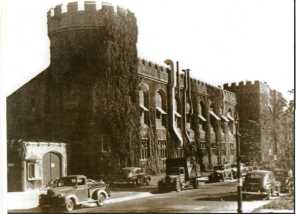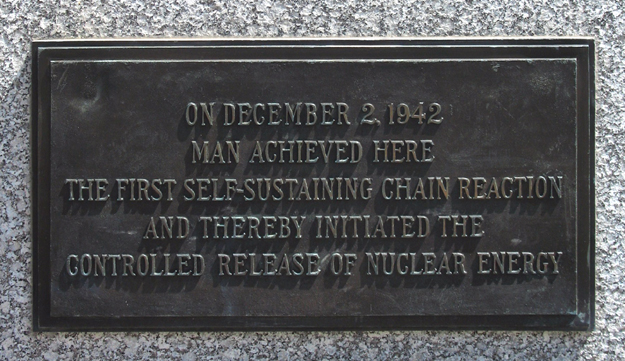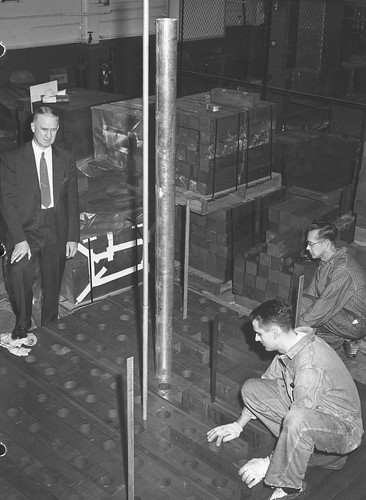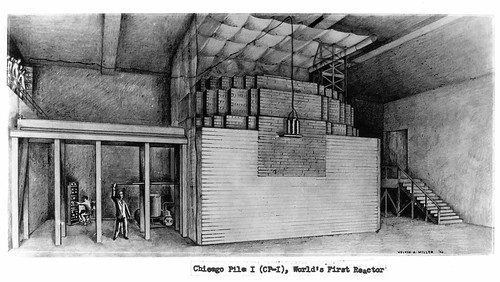
Stagg Field, home of the squash courts which housed the Met Lab's Chicago Pile 1.

Proof that Stagg Field once hosted football.
I passed by the location of Chicago Pile 1 many times in the sixties while competing in open entry track meets held at Stagg Field. While Stagg Field was no longer used for football it was host to many track and field events every year. You never knew who you might see at these events as they were a good opportunity for high level athletes to keep their edge when nothing else was going on and retired athletes entered because they still loved the sport.
The football team had periods of greatness under legendary coach Amos Alonzo Stagg, winning Big 10 championships twice in the twenties. But that was then. In 1939 University of Chicago President Robert Maynard Hutchins disbanded the Maroons, the once powerful football team of the University of Chicago because, in his words, “The whole apparatus of football, fraternities, and fun is a means by which education is made palatable to those who have no business in it.” Universities, he feared, were in danger of becoming “high-class flophouses.”
There was nothing substantial to see as one passed through the passageway beneath the stands on the way to the athletic field. It was all concrete and steel girders, a modest bronze plaque marked the historical location.
The pile and its associated equipment had all been moved shortly after that first controlled chain reaction to another location in a forest preserve known as Argonne Forest. Many of the forest preserves ringing Chicago were named to memorialize World War I battlefields and the Americans who died there in the name of freedom. This was to have been the original location of the pile but unions created an intolerable delay in construction and, since Stagg Field was no longer crowded in the fall, the on campus space was immediately available.
Soon the activities of the Manhattan Project moved to the desert and the projects of the University of Chicago's Metallurgical Laboratory, a cover for the nuclear research, gave birth to Argonne National Laboratory at the new facilities for the Chicago pile, and later helped attract the Fermi National Accelerator Laboratory to a location twenty miles away.
Years later I had the opportunity to visit Leo Seren and his lovely wife at their suburban home in Evanston. Leo was on Enrico Fermi's team and devised ways to accurately measure the density of neutrons in the graphite, uranium and cadmium that composed the pile. He was present at the first sustained reaction under the stands that day. Never able to reconcile his contribution to the death and destruction wrought by the atomic bombs, he became an anti-nuclear proponent.
To this day I benefit from Leo's love of lemon meringue pie. His charming and gorgeous wife, Marge, was undergoing treatments for cancer. Exhausted, she needed a little help around the house and placed an ad. As a college student my future wife responded, and was hired to do cooking, cleaning, and laundry on a part time basis. The two got along very well and my wife hesitated to disappoint when asked if she could make Leo's favorite dessert. Naturally, she responded positively though she had never baked a lemon meringue pie in her life.
Fortunately, she could consult a pro. My grandmother had baked cakes, pies and cookies and made tea sandwiches to make a little extra money during tough times and had continued baking for the rest of her life. Of course she had a time tested recipe for said pie and would coach a brash student through a trial effort.
The results were superb. Marge was able to present Leo with his favorite dessert in spite of her weakened condition and Leo's grateful response was that it was the best he had ever tasted. From nuclear physics to small human pleasures. What was God thinking? Apparently He has greater plans for us than we can know. A future that requires us to persist in the face of obstacles, to keep an eye on our goals while wrestling with the mundane, and to seek a moral path amid countless distractions.

The plaque which now is attached to the base of a Henry Moore sculpture marking
the significance of the site.

Enrico Fermi

Walter Zinn oversees the placement of graphite blocks forming
the first layers that would compose the pile.

An artist's rendering of the Pile. No photos, everything was top secret. It was feared that
if the Germans discovered the status of American research they would redouble their efforts
and be the first with the bomb.

49 people were present to observe the first controled nuclear chain reaction. When the pile
became critical, a self sustaining reaction, a bottle of chianti was produced from a brown bag by
Eugene Wigner and those present toasted the occasion using paper cups. The bottle was passed
around and each person signed the chianti's basket.
A marker noting the underground resting place of Chicago Pile 1 at the original site of
Argonne National Laboritory.
